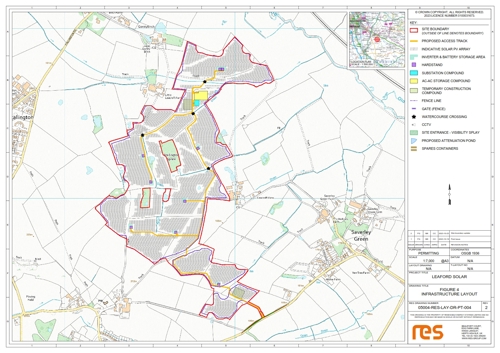Project Update - December 23
Since our public exhibition in July 2023, we have been continuing to refine the design of the solar farm, taking into consideration the results of site surveys and assessments as well as any feedback from the community and stakeholders.As a direct result of feedback, we have made a number of design changes. We have also undertaken additional consultation with outdoor recreation groups and other stakeholders. This has taken a little longer than originally forecast, however, this has helped to further refine the proposal so that the solar farm may sit sensitively into the existing landscape whilst maximising the generation of clean, low-cost electricity.
Design changes which were made include:
- A reduction in the size of the site by nearly 40 acres from c. 208 acres to c. 170 acres.
- Removal of solar infrastructure from the fields to the southwest and southeast, reducing potential visibility from Fulford village and from Saverley Green Road.
- Additional planting on the western boundary to reduce potential visibility.
- A minimum setback of 7.5m from the Public Rights of Way (a larger setback has been achieved in some areas).
- Repositioning of the site entrance to prevent any tree loss.
We have now submitted the application to Stafford Borough Council which was supported by a number of detailed environmental and technical assessments.
The plan below shows the updated layout for the proposed 30MW Leaford Solar Farm which includes energy storage enabling electricity to be stored and released back to the grid network when it is most needed.
Click on image to enlarge
The solar farm has been specifically designed to be dual-purpose allowing continued agricultural use in the form of sheep grazing and the production of renewable energy. Over 95% of the land has been classified as not being Best and Most Versatile.
There will be no long-term loss or reclassification of Green Belt land as a result of the development which is temporary in nature, and the site can be returned to agricultural use at the end of the solar project. Where a solar farm is installed on land which has been intensively farmed, it enables the ground underneath to recover, while providing income for the farming business. Solar farms help regenerate soil quality and can help to ensure the continued availability of high-quality agricultural acreage for future generations.
A Power for Good
Solar farms contribute to Net Zero carbon emission reduction targets, can be quick to deploy, enable more energy to be generated domestically improving security of supply, and are the cheapest form of new electricity generation1 alongside other renewable technologies.
This makes solar farms, like Leaford, not just good for the environment but also for the consumer.
The Leaford Solar Farm proposal would deliver a biodiversity net gain for the site through a range of measures including native planting, wildflower areas and the installation of bird and bat boxes.
We are also consulting on meaningful local benefits which could be delivered by the solar farm, if it is consented. From feedback received to date from the local community and stakeholders, a road safety initiative would be one such initiative which could be delivered. We look forward to continuing further discussion regarding this and also welcome feedback on other suggestions and ideas.
1 https://assets.publishing.service.gov.uk/media/6556027d046ed400148b99fe/electricity-generation-costs-2023.pdf

